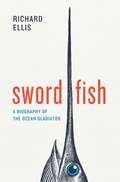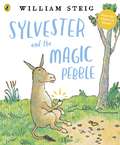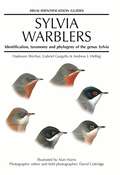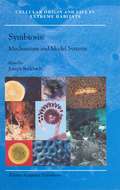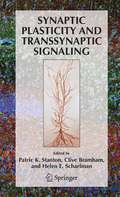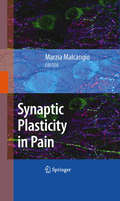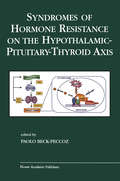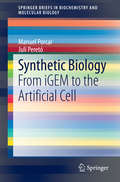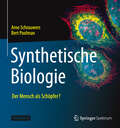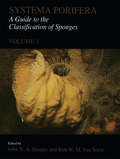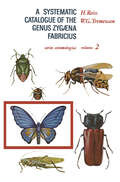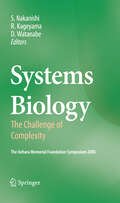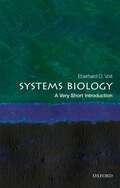- Table View
- List View
Swordfish: A Biography of the Ocean Gladiator
by Richard EllisA perfect fish in the evolutionary sense, the broadbill swordfish derives its name from its distinctive bill—much longer and wider than the bill of any other billfish—which is flattened into the sword we all recognize. And though the majesty and allure of this warrior fish has commanded much attention—from adventurous sportfishers eager to land one to ravenous diners eager to taste one—no one has yet been bold enough to truly take on the swordfish as a biographer. Who better to do so than Richard Ellis, a master of marine natural history? Swordfish: A Biography of the Ocean Gladiator is his masterly ode to this mighty fighter. The swordfish, whose scientific name means “gladiator,” can take on anyone and anything, including ships, boats, sharks, submarines, divers, and whales, and in this book Ellis regales us with tales of its vitality and strength. Ellis makes it easy to understand why it has inspired so many to take up the challenge of epic sportfishing battles as well as the longline fishing expeditions recounted by writers such as Linda Greenlaw and Sebastian Junger. Ellis shows us how the bill is used for defense—contrary to popular opinion it is not used to spear prey, but to slash and debilitate, like a skillful saber fencer. Swordfish, he explains, hunt at the surface as well as thousands of feet down in the depths, and like tuna and some sharks, have an unusual circulatory system that gives them a significant advantage over their prey, no matter the depth in which they hunt. Their adaptability enables them to swim in waters the world over—tropical, temperate, and sometimes cold—and the largest ever caught on rod and reel was landed in Chile in 1953, weighing in at 1,182 pounds (and this heavyweight fighter, like all the largest swordfish, was a female). Ellis’s detailed and fascinating, fact-filled biography takes us behind the swordfish’s huge, cornflower-blue eyes and provides a complete history of the fish from prehistoric fossils to its present-day endangerment, as our taste for swordfish has had a drastic effect on their population the world over. Throughout, the book is graced with many of Ellis’s own drawings and paintings, which capture the allure of the fish and bring its splendor and power to life for armchair fishermen and landlocked readers alike.
Swordfish: A Biography of the Ocean Gladiator
by Richard EllisA perfect fish in the evolutionary sense, the broadbill swordfish derives its name from its distinctive bill—much longer and wider than the bill of any other billfish—which is flattened into the sword we all recognize. And though the majesty and allure of this warrior fish has commanded much attention—from adventurous sportfishers eager to land one to ravenous diners eager to taste one—no one has yet been bold enough to truly take on the swordfish as a biographer. Who better to do so than Richard Ellis, a master of marine natural history? Swordfish: A Biography of the Ocean Gladiator is his masterly ode to this mighty fighter. The swordfish, whose scientific name means “gladiator,” can take on anyone and anything, including ships, boats, sharks, submarines, divers, and whales, and in this book Ellis regales us with tales of its vitality and strength. Ellis makes it easy to understand why it has inspired so many to take up the challenge of epic sportfishing battles as well as the longline fishing expeditions recounted by writers such as Linda Greenlaw and Sebastian Junger. Ellis shows us how the bill is used for defense—contrary to popular opinion it is not used to spear prey, but to slash and debilitate, like a skillful saber fencer. Swordfish, he explains, hunt at the surface as well as thousands of feet down in the depths, and like tuna and some sharks, have an unusual circulatory system that gives them a significant advantage over their prey, no matter the depth in which they hunt. Their adaptability enables them to swim in waters the world over—tropical, temperate, and sometimes cold—and the largest ever caught on rod and reel was landed in Chile in 1953, weighing in at 1,182 pounds (and this heavyweight fighter, like all the largest swordfish, was a female). Ellis’s detailed and fascinating, fact-filled biography takes us behind the swordfish’s huge, cornflower-blue eyes and provides a complete history of the fish from prehistoric fossils to its present-day endangerment, as our taste for swordfish has had a drastic effect on their population the world over. Throughout, the book is graced with many of Ellis’s own drawings and paintings, which capture the allure of the fish and bring its splendor and power to life for armchair fishermen and landlocked readers alike.
Swordfish: A Biography of the Ocean Gladiator
by Richard EllisA perfect fish in the evolutionary sense, the broadbill swordfish derives its name from its distinctive bill—much longer and wider than the bill of any other billfish—which is flattened into the sword we all recognize. And though the majesty and allure of this warrior fish has commanded much attention—from adventurous sportfishers eager to land one to ravenous diners eager to taste one—no one has yet been bold enough to truly take on the swordfish as a biographer. Who better to do so than Richard Ellis, a master of marine natural history? Swordfish: A Biography of the Ocean Gladiator is his masterly ode to this mighty fighter. The swordfish, whose scientific name means “gladiator,” can take on anyone and anything, including ships, boats, sharks, submarines, divers, and whales, and in this book Ellis regales us with tales of its vitality and strength. Ellis makes it easy to understand why it has inspired so many to take up the challenge of epic sportfishing battles as well as the longline fishing expeditions recounted by writers such as Linda Greenlaw and Sebastian Junger. Ellis shows us how the bill is used for defense—contrary to popular opinion it is not used to spear prey, but to slash and debilitate, like a skillful saber fencer. Swordfish, he explains, hunt at the surface as well as thousands of feet down in the depths, and like tuna and some sharks, have an unusual circulatory system that gives them a significant advantage over their prey, no matter the depth in which they hunt. Their adaptability enables them to swim in waters the world over—tropical, temperate, and sometimes cold—and the largest ever caught on rod and reel was landed in Chile in 1953, weighing in at 1,182 pounds (and this heavyweight fighter, like all the largest swordfish, was a female). Ellis’s detailed and fascinating, fact-filled biography takes us behind the swordfish’s huge, cornflower-blue eyes and provides a complete history of the fish from prehistoric fossils to its present-day endangerment, as our taste for swordfish has had a drastic effect on their population the world over. Throughout, the book is graced with many of Ellis’s own drawings and paintings, which capture the allure of the fish and bring its splendor and power to life for armchair fishermen and landlocked readers alike.
Sylvanian Families: An Official Sylvanian Families Story
by Macmillan Children's BooksCome and celebrate Freya the Chocolate Rabbit's birthday with all her friends in the Sylvanian Village in this sweet picture book, based on the animation Freya's Happy Diary, now showing on YouTube!It's Freya's birthday and she's having a party, but her best friends, Ralph Walnut and Lyra Persian, are nowhere to be found! As Freya searches, she meets lots of friends and neighbours who give her presents of shiny, bright balloons. So many balloons, in fact, that she's lifted right into the air!As she soars over the Sylvanian Village, she starts to wonder how she will ever get down . . . and whether her two best friends will turn up in time to help.This adorable picture book features artwork from the animated Sylvanian Families series, Freya's Happy Diary, and brings the classic and beloved toy range to life as never before.Also available: The World of Sylvanian Families: The Official Guide, Easter Search-and-Find and more!
Sylvester and the Magic Pebble (Stories To Go! Ser.)
by William SteigOne rainy day, Sylvester finds a magic pebble that can make all his wishes come true. But when a lion frightens him on his way home, Sylvester makes a wish with unexpected consequences. Will Sylvester find his way back to his family? Winner of the 1970 Caldecott Medal, this modern classic is full of warmth, humour and joy.
Sylvia Warblers: Identification, taxonomy and phylogeny of the genus Sylvia (Helm Identification Guides)
by Andreas Helbig Gabriel Gargallo Hadoram ShirihaiBased on phylogenetic research, this complete study of the genus Sylvia describes two new species and establishes identification criteria for all members of the family.A lengthy introduction explains the background to the research and outlines the main features of the genus. The 25 species are then treated in detail, including the African parisomas, which are here included in the Sylva group. The species accounts include sections on every aspect of identification, with colour illustrations showing age, sex and racial differences, distribution maps, sonograms, moult and wing diagrams and tables."
Symbiosis: Mechanisms and Model Systems (Cellular Origin, Life in Extreme Habitats and Astrobiology #4)
by Joseph SeckbachSymbiosis is the fourth volume in the series Cellular Origin and Life in Extreme Habitats (COLE). Fifty experts, from over a dozen countries, review their current studies on different approaches to these phenomena. The chapters present various aspects of symbiosis from gene transfer, morphological features, and biodiversity to individual organisms sharing mutual cellular habitats. The origin of the eukaryotic phase is discussed with emphasis on cyanelles, H syntrophy, N2 fixation, and S-based symbiosis (as well as the origin of mitochondrion, chloroplast, and nucleus). All members of the three domains of life are presented for sharing symbiotic associations. This volume brings the concept of living together as `One plus One (plus One) equals One.' The purpose of this book is to introduce the teacher, researcher, scholar, and student as well as the open-minded and science-oriented reader to the global importance of this association.
Synaptic Mechanisms in the Auditory System (Springer Handbook of Auditory Research #41)
by Laurence O. O. Trussell, Arthur N. N. Popper and Richard R. R. FaySynaptic Mechanisms in the Auditory System will provide a basic reference for students, clinicians, and researchers on how synapses in the auditory system function to encode acoustic signals. These mechanisms are the groundwork for all auditory processing, and understanding them requires knowledge of the microphysiology of synapses, cellular biophysics, receptor pharmacology, and an appreciation for what these synapses must do for a living, what unique jobs they carry out.
Synaptic Plasticity: Dynamics, Development and Disease
by Michael R. Kreutz and Carlo SalaThis book introduces the current concepts of molecular mechanisms in synaptic plasticity and provides a comprehensive overview of cutting-edge research technology used to investigate the molecular dynamics of the synapses. It explores current concepts on activity-dependent remodeling of the synaptic cytoskeleton and presents the latest ideas on the different forms of plasticity in synapses and dendrites. Synaptic Plasticity in Health and Disease not only supplies readers with extensive knowledge on the latest developments in research, but also with important information on clinical and applied aspects. Changes in spine synapses in different brain disease states, so-called synaptopathies, are explained and described by experts in the field. By outlining basic research findings as well as physiological and pathophysiological impacts on synaptic plasticity, the book represents an essential state-of-the-art work for scientists in the fields of biochemistry, molecular biology and the neurosciences, as well as for doctors in neurology and psychiatry alike.
Synaptic Plasticity and Transsynaptic Signaling
by Patric K. Stanton Clive Bramham Helen E. ScharfmanBrain functions are realized by the activity of neuronal networks composed of a huge number of neurons. The efficiency of information transfer within the networks is changeable. Even the networks themselves can change through experience. Information transfer between neurons is performed at the synapse (the site of the neurons’ contact) by release of neurotransmitters from the pre-synaptic cell and capture of neurotransmitters by the post-synaptic cell. The amount of released neurotransmitter or the efficacy of capture can change. Moreover, synapses are found to be newly formed upon activity or abandoned upon inactivity. These changes are called "synaptic plasticity". This text focuses on one component of synaptic plasticity called transsynaptic signaling, or communication of synapses during their formation.
Synaptic Plasticity in Pain
by Marzia MalcangioPrimary sensory neurons respond to peripheral stimulation and project to the spinal cord. Specifically, the population of neurons which respond to damaging stimuli terminate in the superficial layers of the dorsal horn. Therefore, the dorsal horns constitute the first relay site for nociceptive fibre terminals which make synaptic contacts with second order neurons. It has recently become clear that the strength of this first pain synapse is plastic and modifiable by several modulators, including neuronal and non-neuronal regulators, and studies on the fundamental processes regulating the plasticity of the first pain synapse have resulted in the identification of new targets for the treatment of chronic pain. This book will be of interest to a wide readership in the pain field.
Synaptic Stress and Pathogenesis of Neuropsychiatric Disorders
by Maurizio Popoli David Diamond Gerard SanacoraRecent studies show that changes in Glutamate/GABA synapses and related pathways may determine whether the synaptic plasticity that occurs as a response to stress is adaptive or maladaptive. Findings have shed new light on the mechanisms that determine the effects of stress on cognitive and affective function. Researchers have brought a wide range of techniques to bear on the study of this problem, including cutting-edge live imaging techniques, electrophysiology, glutamate release from isolated live synaptic terminals, development of transgenic and animal models and new behavioral methods. This book provides an overview of these recent findings and of the techniques used as well as a discussion of how the molecular, cellular, and functional effects of stress may trigger or precipitate neuropsychiatric disorders such as depression, schizophrenia, anxiety and PTSD.
Syndromes of Hormone Resistance on the Hypothalamic-Pituitary-Thyroid Axis (Endocrine Updates #22)
by PaoloBeck-PeccozTruly unique cutting edge state of the art information on basic and clinical research. A great help for the clinician to diagnose and treat this uncommon hormone resistance. Basic scientists learn how much has been discovered on the mechanism of hormone action from the mutations of the various genes involved to thyroid hormones and TSH.
Synergetics of Cognition: Proceedings of the International Symposium at Schloß Elmau, Bavaria, June 4–8, 1989 (Springer Series in Synergetics #45)
by Hermann Haken Michael StadlerThis book presents the invited lectures given at the International Symposium on Synergetics of Cognition held at SchloB Elmau, Bavaria (Fed. Rep. of Germany), June 4-8, 1989. The understanding of the processes underlying cognition is certainly one of the most challenging and difficult problems confronting the human mind. It is an enterprise that requires the cooperation of scientists from fields ranging from the neurosciences and psychology through biology to the computer sciences, physics and mathematics. The papers included in this volume reflect this joint effort. As will be evident, there is a remarkable convergence of ideas stemming from various fields, for instance, the earlier ideas on Gestalt theory celebrate a come back and remarkable analogies are being established with modem concepts of self-organization as dealt with in the interdisciplinary field of synergetics. The individual topics range from the "microscopic level", where new exciting results on specific oscillations of neural activity are reported, to computer simulations of perception, and finally psychological experiments at the "macroscopic level". We hope that this book will convey to its readers the same enthusiasm that was felt by the participants of the symposium. We wish to thank Mrs. U. Funke for the excellent organisation of the sym posium, and the Volkswagen-Stiftung, Hannover, for its financial support. We are furthermore grateful to Christoph Stadler and Zora Franko for their help in com piling the name and subject indexes. Finally we wish to thank Springer-Verlag, in particular Dr. Angela Lahee, for the excellent cooperation.
Synthetic Biology: From iGEM to the Artificial Cell (SpringerBriefs in Biochemistry and Molecular Biology #12)
by Manuel Porcar Juli PeretóSynthetic Biology (SB) is a revolutionary discipline with a vast range of practical applications, but is SB research really based on engineering principles? Does it contributing to the artificial synthesis of life or does it utilise approaches sufficiently advanced to fall outside the scope of biotechnology or metabolic engineering? This volume reviews the development of SB and includes the major milestones of the discipline, the ‘top-down’ and ‘bottom-up’ approaches towards the construction of an artificial cell and the development of the “iGEM” competition. We conclude that SB is an emerging field with extraordinary technological potential, but that most research projects actually are an extension of metabolic engineering since the complexity of living organisms, their tight dependence on evolution and our limited knowledge of the interactions between the molecules, actually make life difficult to engineer.
Synthetische Biologie: Die Geburt einer neuen Technikwissenschaft (acatech DISKUTIERT)
by Alfred Pühler Bernd Müller-Röber Marc-Denis WeitzeEine wirtschaftliche und einfache Herstellung komplexer Moleküle für maßgeschneiderte Werkstoffe, Arzneimittel oder auch Treibstoffe, dazu neue Methoden für Forschungszweige wie Biomedizin, Materialwissenschaft oder Katalyseforschung: Die Liste potenzieller Anwendungen der Synthetischen Biologie, einer Forschungsrichtung zwischen Molekularbiologie, Organischer Chemie, Nanobiotechnologie und Informationstechnik, ist lang. Ausgehend von der bereits großen Bedeutung der Biotechnologie in der chemischen Industrie könnte es in den nächsten Jahren zu einer regelrechten Biologisierung der Wirtschaft kommen. Die neue Technikwissenschaft an der Grenze von Biologie und Technik übt eine große Faszination aus, die dieser Band weitergeben möchte - freilich ohne die Herausforderungen auszublenden.
Synthetische Biologie - Der Mensch als Schöpfer?
by Arno Schrauwers Bert PoolmanSynthetische Biologie ist ein neuer Wissenschaftszweig, der große Hoffnungen auf Fortschritte in der Medizin, in der Landwirtschaft und in den Energie-, Ernährungs- und Gesundheitswirtsschaftszweigen weckt. Zurzeit ist die Forschung so weit, dass man - wenn auch noch recht primitiv - neues Leben erschaffen kann.Obwohl molekulare Genetik kein Alltagsthema ist, wird sie hier so dargestellt, dass ein breites Publikum sie leicht verstehen kann. Es wird erzählt, wie das Erbgut, die DNA, entschlüsselt wurde und wie man sie heute synthetisch produzieren kann. Dabei werden die Risiken und philosophisch/ethische Bedenken nicht verschwiegen.Dieses Buch führt den Leser anhand von Fragen durch das faszinierende Thema:Was ist Leben? - Wie ist das Leben entstanden? - Können wir neues Leben schaffen? - Ist nur DNA-Leben möglich? - Was wissen wir von der Zelle? - Was sind die Chancen der Synthetischen Biologie? - Synthetische Biologie in der Laborpraxis - Was können wir erwarten? - Was sind die Risiken?
Systema Porifera: A Guide to the Classification of Sponges
by Rob W. M. Van Soest John N. A. HooperResearch whilst compiling this book has uncovered a fauna about twice the size as that previously published in the literature and consequently Systema Porifera revises and stabilizes the systematics of the phylum to accommodate this new knowledge in a contemporary framework. Practical tools (key illustrations, descriptions of character) are provided to facilitate the assignment of approximately 680 extant and 100 fossil genera. Systema Porifera is unique making sponge taxonomy widely available at the practical level of classification (genera, families, order). It is a taxonomic revision of sponges and spongiomorphis (such as sphinctozoans and archaeocyathans) based on re-evaluation of type materials and evidence. It is also a practical guide to sponge identification providing descriptions and illustrations of characters and interpretation of their importance to systematics. Systema Porifera addresses many long standing nomenclatural problems and provides a sound baseline for future debate on sponges and their place in time and space. Systema Porifera describes 3 classes, 7 subclasses, 24 orders, 127 families and 682 valid genera of extant sponges (with over 1600 nominal generic names and an additional 500 invalid names treated). Treatment of the fossil fauna is less comprehensive or critical, although 6 classes, 30 orders, 245 families and 998 fossil genera are mentioned. Keys to all recent and many fossil taxa are provided.
A Systematic Catalogue of the Genus Zygaena Fabricius (Series Entomologica #2)
by H. Reiss W.G. TremewanIt is forty years since Burgeff published, in 1926, the first comprehensive catalogue of the genus Zygaena Fabricius, forming part 33 of the Lepidopterorum Catalogus. Following the pattern and general layout of Burgeff's work, we have attempted to produce a catalogue in which all names in the genus Zygaena are included, with references to the literature where these names were originally published. Additional references are included when these refer to illustrations of a species, subspecies or form, or to a taxonomic change, e.g., a change in status. References to misidentifications are generally omitted unless a new species has been described at a later date. In compiling this work we have adhered to the International Code of Zoological Nomenclature as adopted by the XV International Congress of Zoology. However, although the International Commission on Zoological Nomenclature recognises the necessity of names of lower rank than subspecies, they do not at present deal with such names. The provisions of the Code do not apply to them and, therefore, such names have no nomenclatural status. Every subspecies is given equal status in the catalogue although their relative value is not always the same. Certain authors have very often separated sub species on minute differences and a subsequent examination of further material, taken over a number of years, has shown that the differences are not always constant. In many cases, however, we have been unable to verify the status of each subspecies.
A Systematic Catalogue of the Genus Zygaena Fabricius (Series Entomologica)
by Hugo Reiss W. Gerald TremewanSystems Biology: The Challenge of Complexity
by Shigetada Nakanishi Ryoichiro Kageyama Dai WatanabeBiological signaling pathways dynamically interact with one another to form complex information networks intracellularly, intercellularly, and eventually at the level of the organism. Biology and medicine have conventionally focused on identification and characterization of functional elements in biological signaling pathways. Recently, research in this field has pursued a new approach, systems biology, to understand the dynamics, complexity, and physiological functions of the biological signaling networks. Instead of reductionistic analyses or large-scale studies of biomolecules piece by piece, systems biology emphasizes the need for interdisciplinary methods and analysis of the regulation and operation of information networks at the systems level. The contributors to this book are leading researchers in the rising field of systems biology. Readers will find not only the most recent advances in research, but also the latest information about interdisciplinary methods and related topics.
Systems Biology: Vignettes In Systems Biology (Very Short Introductions)
by Eberhard O. VoitSystems biology came about as growing numbers of engineers and scientists from other fields created algorithms which supported the analysis of biological data in incredible quantities. Whereas biologists of the past had been forced to study one item or aspect at a time, due to technical and biological limitations, it suddenly became possible to study biological phenomena within their natural contexts. This interdisciplinary field offers a holistic approach to interpreting these processes, and has been responsible for some of the most important developments in the science of human health and environmental sustainability. This Very Short Introduction outlines the exciting processes and possibilities in the new field of systems biology. Eberhard O. Voit describes how it enabled us to learn how intricately the expression of every gene is controlled, how signaling systems keep organisms running smoothly, and how complicated even the simplest cells are. He explores what this field is about, why it is needed, and how it will affect our understanding of life, particularly in the areas of personalized medicine, drug development, food and energy production, and sustainable stewardship of our environments. Throughout he considers how new tools are being provided from the fields of mathematics, computer science, engineering, physics, and chemistry to grasp the complexity of the countless interacting processes in cells which would overwhelm the cognitive and analytical capabilities of the human mind. ABOUT THE SERIES: The Very Short Introductions series from Oxford University Press contains hundreds of titles in almost every subject area. These pocket-sized books are the perfect way to get ahead in a new subject quickly. Our expert authors combine facts, analysis, perspective, new ideas, and enthusiasm to make interesting and challenging topics highly readable.
Systems Biology in Animal Production and Health, Vol. 1
by Haja N. KadarmideenThis two-volume work provides an overview on various state of the art experimental and statistical methods, modeling approaches and software tools that are available to generate, integrate and analyze multi-omics datasets in order to detect biomarkers, genetic markers and potential causal genes for improved animal production and health. The book will contain online resources where additional data and programs can be accessed. Some chapters also come with computer programming codes and example datasets to provide readers hands-on (computer) exercises.This first volume presents the basic principles and concepts of systems biology with theoretical foundations including genetic, co-expression and metabolic networks. It will introduce to multi omics components of systems biology from genomics, through transcriptomics, proteomics to metabolomics. In addition it will highlight statistical methods and (bioinformatic) tools available to model and analyse these data sets along with phenotypes in animal production and health. This book is suitable for both students and teachers in animal sciences and veterinary medicine as well as to researchers in this discipline.
Systems Biology in Animal Production and Health, Vol. 2
by Haja N. KadarmideenThis two-volume work provides an overview on various state of the art experimental and statistical methods, modeling approaches and software tools that are available to generate, integrate and analyze multi-omics datasets in order to detect biomarkers, genetic markers and potential causal genes for improved animal production and health. The book will contain online resources where additional data and programs can be accessed. Some chapters also come with computer programming codes and example datasets to provide readers hands-on (computer) exercises.This second volume deals with integrated modeling and analyses of multi-omics datasets from theoretical and computational approaches and presents their applications in animal production and health as well as veterinary medicine to improve diagnosis, prevention and treatment of animal diseases. This book is suitable for both students and teachers in animal sciences and veterinary medicine as well as to researchers in this discipline.
